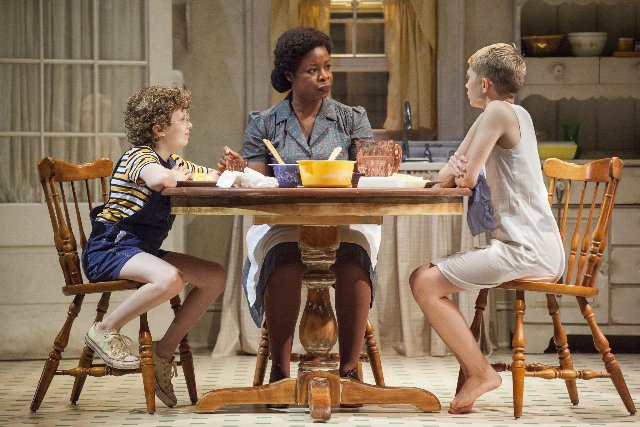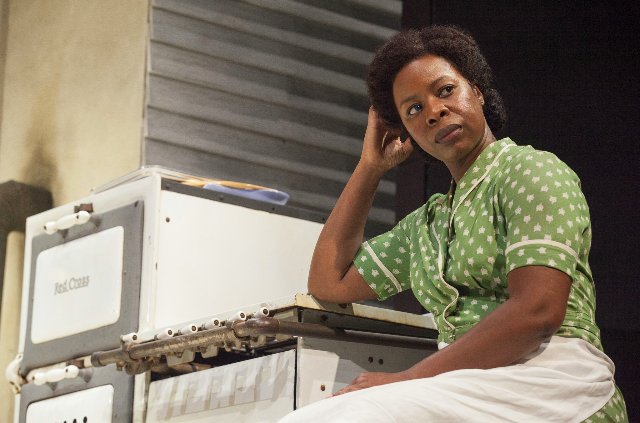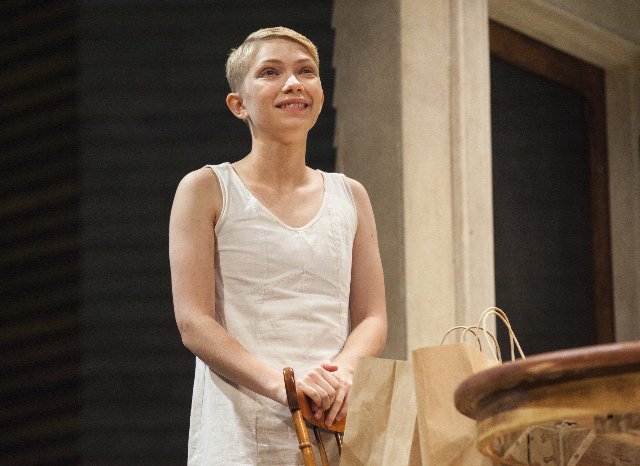The Member of the Wedding
Williamstown Revises Carson McCullers Play
By: Charles Giuliano - Aug 10, 2018
The Member of the Wedding
By Carson McCullers
Directed by Gaye Taylor Upchurch
Scenic design, Laura Jellinek; Costumes, Clint Ramos; Lighting, Isabella Byrd; Music and sound, Bray Poor; Hair and wigs, Leah Loukas; Dialect coach, Charlotte Fleck.
Cast: Roslyn Ruff (Bernice Sadie Brown), Tavi Gevinson (Frankie Addams), Logan Schuyler Smith (John Henry West), Tom Peckina (Jarvis), Louisa Jacobson (Janice), James Waterston (Mr. Aadams), Liv Rooth (Mrs. West), Vinnie Burrows (Sis Laura), Leon Addison Brown (T.T. Williams), Will Cobbs (Honey Camden Brown), Ben Ahlers (Barney MacKean), Delilah Napier (Helen Fletcher), Sarah Haga (Doris)
Williamstown Theatre Festival
Main Stage
August 5 to 19, 2018
In an unusual pratfall for Williamstown Theatre Festival, the set designed by Laura Jellinek, is sprawling, clunky, asymmetrical and off kilter. Unfortunately, it is a too apt metaphor for a revival of the 1950 play The Member of the Wedding by Carson McCullers.
We contemplate a formidable, clapboarded wall which angles across the stage. It is bookended by a trellis and grape vine, and expanse comprising a yard and pass through, then stage left on a raised platform a cutaway box evoking a kitchen with circa 1930s appliances and cabinets.
That vast back wall puzzles regarding its functionality. A primarily autobiographical writer, for McCullers the time and place August, 1945 is specific to a character, based on herself at 12, located at home in Columbus, Georgia.
The lighting designed by Isabella Byrd plays colors and mood swings across the horizontally striped surface. There is an effect of lightning striking with thunderous sound conveyed by Bray Poor. It frightens the child John Henry with forboding of worse to come.
The WTF production, directed by Gaye Taylor Upchurch, opts to bypass site specificity. There is nothing indicating mid-'40s Georgia. The intent is to disregard a dated, Southern gothic play deconstructed to here and now. We follow threads of adolescence, gender, identity, race and sociopolitical issues of white children raised by black servants.
The norm with those imposing, restrictive walls is to see them morph into something else. It arouses our curiosity and anxiety of what they hide. Nothing is ever revealed. Indeed, key events referred to in the script are blind to us. There is a a paradox of what we do and don't know about what transpires.
As in a Greek tragedy, horrific events including terminal illness, murder and suicide are vividly described but not seen. Further there are obfuscating lines in which characters vaguely discuss key events glimpsed out of the corner of their eyes.
The essential vision thing is an unexplored plot point.
Beginning and ending the play are moody, reflective, absoring solo scenes with the remarkable Roslyn Ruff as the black servant Bernice Sadie Brown.
During the performance we attended there was an awkward moment as the actress struggled to open the kitchen door. The wall of the set shook before she entered and illuminated the space. She then moved about putting on a apron and preparing her daily tasks.
We wonder about the patch on an eye. Later, turning away from us, she puts in the glass eye that the child John Henry West (Logan Schuyler Smith) has found in her handbag. From then on she performs as sighted. With childish innocence John Henry questions what she can see and which is the better eye.
That never makes sense. What was the trauma that caused her to loose the eye? In what manner is it a signifier for her character?
The playwright was born Lula Carson Smith on February 19, 1917. At 20 she married a former soldier and aspiring writer Reeves McCullers. They divorced and later remarried.
In her 30s she suffered illness and partial paralysis. It is known that she pursued romance with women, some of them famous. Her friend Tennessee Williams, however, reported that he doubted that any were sexually consummated. Her husband died of an overdose of pills resulting from a suicide pact which she chickened out of.
The takeaway is that a sordid sensibility pervades her work. That is embodied in the riveting, quirky, precocious but terribly naïve twelve-year-old Frankie (call me F. Jasmine) Addams. The child is played in a titter tatter manner by the 22-year-old Tavi Gevinson.
We wonder how a child can perform such a demanding and complex role. Well, the truth is, she isn’t. A child that is. But there are physical features that allow Gevinson to pass for a juvenile actually almost half her age. Gevison is smallish, gawky and flat-chested projecting a plausible, prepubescent persona.
Charlotte Fleck is credited as dialect coach but there is barely a whiff of Southern accents. The voices are as generic as regional, middle market news broadcasters.
The adolescent Frankie is brilliant, quirky, hyper and conflicted up the wazzoo. Intially, McCullers wrote her as in love with her piano teacher. That was likely based on fact. But the novel/drama was vastly improved when the love interest turned to her big brother. As such it is an impossible love that will know no name. In a sharp encounter she harangues him for all of her outpouring of love and numerous unanswered letters. He counters with a gift of a doll which is the last thing on earth she wants. It's embraced by her confused cousin John Henry.
It is normal for children to be probing and unsure of gender identity. But are these kids destined to grow up gay? That's hinted at when Bernice discussed a man who turned into a girl. These were outré issues in 1940s Georgia.
Frankie has hacked her hair off in a manner that seems normal today but wasn’t in 1945. She isn’t into being girlish which is why she doesn’t fit in. The fat girl who just moved in next door, and spends all day practicing piano, has been unanimously voted into the club that rejected Frankie.
Repressed feeling of otherness inform the character. In real life, like the girl Frankie despises in the play, at 17 McCullers left Georgia for New York to prepare for a career as a concert pianist.
Key to the persona of Frankie is rejection of feminine identity. But, as a member of the wedding, she must gussy up for the event. Unseen she has shopped downtown. Frankie tells anyone who will listen of her intent to leave town and join the honeymoon. Costume designer Clint Ramos had great fun creating a hilarious flouncy, layered orange outfit. Her father describes it as seeing a Christmas tree in August. Bernice to the rescue altering it into something a tad more sensible.
There are other characters and events in the play but we wonder why. The dramatic focus is on the power trio and dynamics of Bernice and the two kids she cares for.
The ambient subtext is the Jim Crow South during the final days of WWII. Black soldiers knew freedom during service in Europe. While the military was segregated they were treated with respect by the French and even Germans.
Back home in Georgia it was samosamo.
Frankie’s brother Jarvis (Tom Pecinka) is home on leave and soon to marry Janice (Louisa Jacobson). Frankie has a plan of being a part of their “we.” Their names begin with Ja and she will call herself F. Jasmine. Joining them on their honeymoon is an absurdity. It is obvious to everyone including the audience. Kids have fantasies of running away from home but this is a bit much.
There is a subplot about the marriages and romances of Bernice. There are few boundaries as they probe her private life. She has had four marriages but only one to a man she loved. He died after a few years and we aren’t clear on how and why?
T.T. Williams (Leon Addison Brown) shows up but he is little more than an occasional date. He is handsome, polite and subservient in the manner that was expected under Jim Crow. His sidekick, Honey Camden Brown (Will Cobbs), is not. The brother of Bernice, up to no good and headed for a bad end, has a trumpet. We don’t know why but we hear it played briefly off stage. He hits up Bernice for reefer money.
The first act focuses primarily on kitchen events. There are hints of gender and race issues but nothing inflammatory. The coming of age aspect is benign to the point of enervating.
In a flash the play turns dark in the second act. Mr. Addams (James Waterson), mostly notable for apathy to Frankie, shows up in the kitchen. He has a chore in mind and wants to hire the two men. There is obsequious hemming and hawing from T.T. Not so from Honey who responds that he’s busy. Read that as he ain’t no boy and buzz off working for no man.
Good old boy Southern racism strikes with the “N” word. The Southern “Gentleman” wonders when returning soldiers will get over their arrogance and get back to the way things was. An essay in the program documents that there was an outbreak of lynchings. There were numerous instances of black men hung while in uniform. Post war Georgia wasn't Paris.
Arguably it is this shift and tragic consequences that provide cred for an elaborately staged production. The play had far more impact on audiences in 1950 than 2018.
What lingers is the stunning, deeply felt, performance of Ruff. With great conviction she conveyed generations of black women who knew their place but brought up motherless children with warmth, insight and Christian charity. Frankie was indeed motherless, and essentially fatherless. In many instances wealthy white women were too busy with privileged lifestyle to spend quality time with their children.
It is a paradox of racist southern culture that white people love the blacks who raised and served them. It is poignant and genuine when Bernice embraces and nurtures the children. Then cowers before their hate filled, ignorant father.
As a young adult the performance of Gevinson was often over the top, shrill and strident, but reasonably convincing as a brilliant, troubled child.
In a supporting role an actual child Schuyler Smith was a pure delight. He stole every scene he was part of. A little gender bender he was hilarious camping about, first in Bernice’s shoes, and later in a flouncy fairy dress. At a young age he is a stage and screen veteran and member of Actor’s Equity.
This production is the third and last for the Main Stage of Williamstown Theatre Festival 2018.




